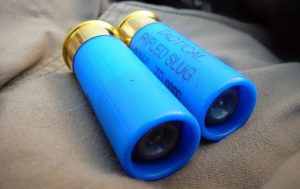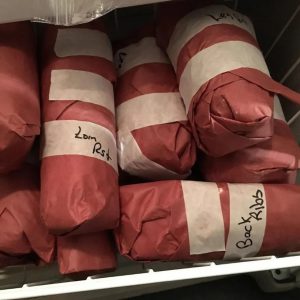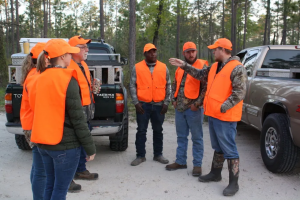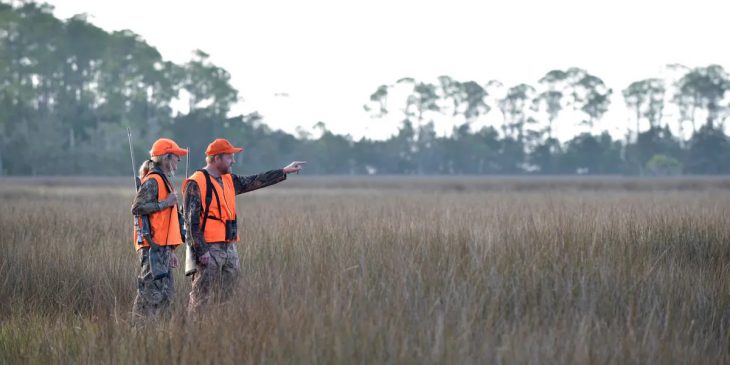Lead contamination in hunted meat has the potential to impact the health of millions of people in the U.S. who are connected to the hunting community, including low-income recipients of venison donations.
However, a lack of communication from public health agencies and health professionals leaves people who eat hunted meat without a trusted source of information about the health risks and advice for reducing exposure to lead.
An investigation of dozens of studies about lead in hunted meat, preventative information about lead, and questionnaires used to identify patients at high risk for lead exposure, along with hours of interviews with hunters who use lead ammunition, revealed a concerning disparity between what is known about risks of exposure to lead in hunted meat, and what is shared with the hunting community. Hunters reported either never hearing about this topic, or hearing about it from perceived anti-hunting sources, resulting in a deep mistrust about the topic of lead. In addition, healthcare providers and health departments are not including the dangers of lead in wild game in their preventative information or questionnaires to identify children and pregnant women at risk for lead exposure.
There is no safe level of lead in the blood. Levels above 5 micrograms/deciliter (μg/dL) are considered elevated and have been associated with Attention Deficit Hyperactivity Disorder (ADHD) and decreased IQ. However, developing brains exposed to even lower levels are at risk for attention-related behavioral problems, decreased cognitive performance, and increased incidence of problem behaviors.
Although neurotoxic effects of lead may be the most widely-known, low levels of lead in the blood have been associated with a range of serious health effects, including kidney disease and impacts to the cardiovascular system. The mechanisms behind the toxic effects of lead are not fully understood.
As lead ammunition use continues to be widespread among U.S. hunters, experts say it is crucial that health officials get a message out to hunting communities, including useful advice for hunters who will continue to use lead. Hunters want to know what the risks are and what options they have to keep their families safe.
This is also an issue of environmental reproductive justice for girls and women who, with each meal of contaminated meat, add to the burden of lead in their bones that can affect the outcomes of their future pregnancies.
Dr. Ned Ketyer, Washington County, Pennsylvania-based pediatrician, told EHN, “We’re learning more every day about the significant adverse health impacts of lead on human health, especially children’s health.
“As we continue putting more lead into the environment, and continue to expose ourselves and our children to lead, at some point it makes sense to say, ‘Wait a minute, what are we doing?'”
From bullet to meat

Researchers found lead ammunition fired from high-powered rifles contaminated carcasses more than slower-moving lead slugs fired from shotguns. (Credit: mr.smashy/flickr)
While lead was banned from waterfowl ammunition in the U.S. in 1991, the majority of people who hunt other types of game use lead ammunition.
Upon impact, a lead bullet can fragment into tiny microparticles, too small to see with the naked eye or sense when eating. A deer processor in Pennsylvania who requested anonymity shared his first-hand experience. “Seventy-five percent of the time when I find a bullet in the carcass, I only find the base. I know the lead is all in the meat somewhere,” he told EHN.
Scientists have used X-rays to visualize and count sometimes hundreds of minute lead particles in hunted meat, and have detected high concentrations of lead in hunted carcasses using chemical analysis. Although the U.S. Food and Drug Administration does not recognize a safe limit for the amount of lead in meat, the European Commission set maximum levels at 0.1 parts per million (ppm).
Concentrations of lead more than 100 times this limit have been detected in the meat of lead-shot carcasses as far as six inches from the entry wound.
In 2009, biologists from the Minnesota Department of Natural Resources x-rayed deer and sheep carcasses that were shot with lead ammunition to make any lead fragments visible. They found some types of lead bullets fragmented more than others, and that fragmentation was more extensive when poorly-placed shots struck large bones.
They also found that lead ammunition fired from high-powered rifles contaminated carcasses more than slower-moving lead slugs fired from shotguns.
From meat to humans
For most people, lead exposure occurs primarily through eating, drinking, or inhalation. While inhaling airborne lead from gun smoke produced by a firearm is a recognized risk factor for lead exposure, eating lead-contaminated meat is widely ignored, despite scientific evidence.
Multiple studies have found a direct link between game harvested with lead ammunition and spikes in blood lead.
- In a 2009 study, pigs were fed deer meat that was harvested with lead ammunition and researchers observed increasing blood-lead concentrations within days. “We conclude that people risk exposure to bioavailable lead from bullet fragments when they eat venison from deer killed with standard lead-based rifle bullets and processed under normal procedures. At risk in the U.S. are some ten million hunters, their families, and low-income beneficiaries of venison donations,” the authors wrote.
Three studies about consumption of lead-hunted meat were published in 2018.
- One estimated that traditional foods such as moose and deer meat provided as much as 73 percent of dietary lead intake but less than 2 percent of total calories for indigenous people in Ontario, Canada.
- Another found that people in the Cree Nations of Quebec, Canada, with elevated (>5 μg/dL) blood-lead levels reported eating significantly more traditional game compared to people without elevated blood-lead levels.
- And another published in The American Journal of Medicine reported on a subsistence hunter in New Zealand whose blood-lead levels were 74.7 μg/dL. The ground game meat he was consuming regularly was found to contain lead. After switching to non-lead ammunition, the hunter’s blood-lead levels began to decrease dramatically.

Hunted venison is typically part of the menu at the Tent, an annual event for hunters in the Allegheny National Forest since 1947. (Credit: Mike Bleech)
After an adult’s digestive system absorbs lead from a meal, the resulting concentration of lead in the blood typically decreases by approximately 50 percent every month. But that doesn’t mean all the lead has left the body. Instead, some lead moves from the blood to the skeleton, where it remains for decades.
As a result, blood-lead levels can be deceivingly low months after peak consumption of lead-hunted meat. For example, a study in Greenland identified a clear seasonal variation in blood lead levels, with peaks during the months when consumption of hunted meat was highest, and decreases during months of lower consumption.
No study has been conducted in the U.S. to understand monthly patterns of blood-lead levels among people who eat lead-hunted meat. Yet the National Shooting Sports Foundation states, “A study from 2008 by the U.S. Centers for Disease Control and Prevention (CDC) on blood- lead levels of North Dakota hunters confirmed that consuming game harvested with traditional ammunition does not pose a human health risk.”
However, the referenced study collected blood samples five months after the hunting season, and reported results for people who ate wild game in general – it was not determined whether the meat was hunted with archery, non-lead ammunition, or lead ammunition. A significant difference of 0.30 μg/dL was observed between the average concentration of lead in the blood of people who reported eating wild game compared to those who did not.
From the mother’s bones to the fetus

Children hunters. (Credit: U.S. Army Corps of Engineers Savannah District)
There are some potential consequences of lead exposure unique to women and their fetuses. Due to hormonal changes during pregnancy, lead that has been stored in the skeleton is released into the blood, exposing both mother and fetus. As a result, high levels of lead in mothers’ bones have been identified as a risk factor for impaired mental development in infants.
In addition to neurotoxic effects, potential consequences to the fetus or infant include low birthweight and spontaneous abortion.
One study of pregnant women found the odds of a spontaneous abortion nearly doubled for each 5 μg/dL increase in blood lead. Lead is also a major risk factor for preeclampsia, a high-blood pressure condition that can have severe consequences for the mother and infant. Women who experience adverse pregnancy outcomes such as preeclampsia face increased risk of cardiovascular and metabolic diseases as they age.
“Many pregnant and breastfeeding women aren’t receiving recommended screening for lead exposure, and even those who are screened may not be asked the right questions to detect all potential sources of exposure,” Dr. Jennifer Braverman, assistant professor in the Division of Maternal Fetal Medicine at University of Colorado, told EHN. “Asking women about consumption of lead-hunted meat may identify women at risk of adverse outcomes who are currently being missed.”
Doctors decide whether to test a pregnant woman’s blood based on answers to a questionnaire about exposure to lead. However, consumption of hunted meat is not included in any of the 12 risk factors for lead exposure recognized by the American College of Obstetricians and Gynecologists, and is also absent from the U.S. Centers for Disease Control and Prevention’s (CDC) Guidelines for the identification of lead exposure in pregnant and lactating women.
Even though some parts of a lead-hunted carcass may be free of lead and safe for pregnant women to eat, it is not possible to identify contaminated meat with the naked eye, and levels of contamination vary from carcass to carcass.
Dr. Braverman told EHN that since it’s not clear how to choose safe portions of lead-hunted meat, preventative information about lead-hunted meat could be provided along with other nutritional advice. “We provide education about mercury. We talk about how to avoid listeria. I think it’s reasonable to add to that, ‘don’t eat lead-hunted meat.'”
Braverman also emphasized that even if women avoid ingesting lead during pregnancy, the lead they accumulated before pregnancy can still pose risks.
“Certainly it would be better to avoid lead exposure for your whole life.”
Children who eat hunted meat are ignored too
Childhood prevention information related to hunted meat is absent from the American Academy of Pediatrics, the CDC, EPA, and guidance from state health departments such as this brochure from the Pennsylvania Department of Health. Although the New York Department of Health issued the following statement, “…people who eat game harvested with lead shot may be exposed to lead.
This is of greatest concern for young children because they are particularly susceptible to the toxic effects of lead,” the topic is absent from the department’s advice on Childhood Lead Poisoning Prevention. The Wisconsin Department of Health Services acknowledges concerns about lead exposure from eating hunted meat, and recommends use of non-lead ammunition. However, the topic is absent from the department’s lead prevention information, ‘Feeding Your Child.’
The most common policy in the U.S. is for children to have their blood-lead levels tested by the age of two, before they are likely to consume large amounts of hunted meat. But exposure to lead after the age of two matters. Blood-lead levels of 6-year-olds have been more strongly associated with impaired cognitive and behavioral development compared to blood-lead levels measured earlier in childhood. This highlights the importance of questionnaires for identifying older children at high risk of lead exposure, and the need for a question about consuming hunted meat.
“It’s something pediatricians should be asking. ‘Do you eat venison or other locally hunted meat?’ – it might be useful to add this question to the lead questionnaire we give to parents of infants and toddlers,” Dr. Ketyer told EHN.
A lack of lead inspection in donated venison

Venison meat. (Credit: Chris Davies/flickr)
These concerns extend to those who eat venison donated to food pantries.
Venison donation programs have provided millions of meals to food banks across the country. States with venison donation programs include those that also harvest the most deer: Texas, Michigan, Pennsylvania, Wisconsin, and Georgia. None of these five states require x-ray inspection of meat for lead contamination.
In 2008, a study analyzed nearly 200 packages of venison from food pantries in Wisconsin, but it is unknown how many packages contained meat that was hunted with firearms. Lead was detected in 15 percent of packages; the average level in lead-contaminated meat was 160 ppm. At this concentration of lead, the study predicted 81 percent of children who consumed just two meals of venison per month would experience blood-lead levels above 10 ug/dL.
In terms of other states, Minnesota requires x-ray inspection due to documented lead contamination of donated venison. However, North Dakota and Iowa currently accept venison donations to food banks without lead inspection, despite previous findings of lead contamination.
The Iowa Department of Public Health has responded, pointing out that no cases of concerning blood-lead levels in the state’s children have ever been attributed to lead in venison. However, this fails to recognize that most children tested in Iowa’s program are tested from ages 0-3. This also fails to take into consideration that blood-lead levels tested several months after the hunting season may be deceptively low.
Smear and fear
Evidence of lead contamination in donated venison first came to light in 2008. North Dakota hunter and physician Dr. William Cornatzer saw an x-ray image of a lead-contaminated carcass during a board meeting of the Peregrine Fund, a conservation organization focused on birds of prey. Soon after, he led a project to x-ray packages of venison donated to the state’s food banks. The images revealed lead contamination in 60 percent of samples. “I about fell out of my chair.” he told EHN. He realized his children and pregnant wife had likely been exposed to lead from his own hunted venison.
“I don’t think humans should be eating lead-contaminated meat, and I don’t think we should be donating it to people who can’t afford alternatives,” he said. “Unfortunately, a lot of people took this as, ‘Somebody’s trying to take my bullets away, somebody’s trying to take my guns away.'”
The Peregrine Fund issued a statement in response to accusations directed at Dr. Cornatzer and characterizations of the organization as “anti-hunting extremists”: “To build support for their own agenda, special interest groups have deliberately tried to smear the integrity of thoughtful, dedicated health and wildlife professionals and create fear of losing hunting and gun rights among their constituents. ‘Smear and fear’ is a well-known technique for manipulating public opinion when facts are absent. Their action is disingenuous and not in the interests of wildlife or human health, including the health of their own constituents.”
Across the state line, Lou Cornicelli, Wildlife Research Manager and author of the Minnesota Department of Natural Resources special report on lead contamination of hunted meat, had a similar experience.
“I got crazy accusations just because we described what might happen if you shoot a lead bullet,” Cornicelli told EHN. “It evoked a strong reaction from people, like ‘The next thing you’re going to do is take my guns away.'”
At the time Cornicelli ran the state’s big game program and was responsible for regulation-setting, the annual harvest was roughly a quarter of a million deer per year. And yet he received accusations of being a secret agent for the organization People for the Ethical Treatment of Animals (PETA).
“People would ask, ‘Are you an anti-hunter?’ No. Just because I don’t want to eat lead doesn’t mean I’m against hunting,” he said.
When asked for a comment regarding lead-contaminated meat, the National Shooting Sports Foundation (NSSF) sent a link to their factsheet on lead-based ammunition, which claims the lead detected in North Dakota’s donated meat was part of the Peregrine Fund’s agenda to ban lead ammunition. In reality, the stated mission of the Peregrine Fund is to “…preserve our wildlife conservation and hunting heritage through voluntary incentive-based outreach and education aimed at increasing the use of non-lead alternatives.”
The NSSF also told EHN that their support for educating hunters extends to “…discussing options hunters have for limiting exposure such as burying entrails after field dressing and careful meat processing.”
Hunters want to hear from a trusted source

Group of deer hunters. (Credit: Florida Fish and Wildlife/flickr)
Natural resources officials may be appropriate messengers to discuss lead-contaminated meat, however, there are two problems. Elaboration on potential health effects is often avoided, viewed as the domain of health departments. Second, many hunters strongly disagree with their state’s deer management decisions, and view any information from the responsible department with deep suspicion.
Kevin, Perry, and brothers Robert and Gary have been hunting together with lead ammunition for decades, since they were 12. We met with them in November and they requested EHN use their first names only. They believe that advice about how to avoid the potential health effects of consuming lead-shot meat should be more accessible to the hunting community.
According to Kevin, lead exposure is not a topic of conversation among hunters.
“It’s not really brought up. People in the hunting community don’t really know about it,” he told EHN.
Robert believes this should change, and emphasized the need for information to be free of anti-hunting or anti-ammunition agendas.
“I think it’s important not just for hunters to understand it, but for people who are ingesting the meat from hunters, whether it’s their families or people eating what’s been donated, that they understand there are potential consequences,” he told EHN. “But it has to be clear there’s no hidden agenda …It needs to be pure, science-driven, ‘here are the facts, we’re not legislating anything, just saying here’s what the issues are.'”
Gary sees opportunities for communication by healthcare providers. He told EHN, “I was in the doctor’s office today, my heart doctor. You go in, just like when you go to the diagnostic center, and they have those pamphlets – ‘Are you a lady of childbearing years?’ ‘Are you a pre-diabetic?'” He suggested that information about lead-hunted meat be presented similarly, “Why can’t that information be funneled through the health industry into pamphlets?”
For Perry, the issue centers on information parents should receive before their child is old enough to start eating lead-shot meat. “I would say one of the biggest possibilities is a pediatrician. The biggest. Because you’re feeding that baby deer meat once it gets older,” he told EHN. “Somebody’s going to come in there with their baby, and the pediatrician will check it all over, and then say ‘Oh here, this is what I want you to read.’ The doctors have to get it out there.”
“How we communicate is the key”
Dr. Ketyer emphasized that it’s not just about what is being communicated, but the way it is communicated.
“How we communicate is the key. This is not about challenging the hunting lifestyle— we need to consider what would be most useful for families that hunt,” he said. “People should have an opportunity to understand the risks to themselves and their children. ‘I didn’t know’ is not acceptable to a pediatrician.”
While switching to alternative ammunition is the most effective way to eliminate lead contamination of hunted meat, Cornicelli said he understands why many hunters choose to continue using lead ammunition. “There are real reasons why people don’t switch … the commercial availability of copper is lower, and the price is higher,” he said. “A large shift to copper is going to be predicated on manufacturers ramping up production, driving costs down, and making availability more broad.”
As a result, Minnesota’s DNR provided hunters with examples of ways to reduce lead exposure, even if they continue to use lead ammunition. These include selecting shotguns instead of high-powered rifles, and avoiding acidic cooking ingredients, since acids can dissolve even more of the lead into the food.
Additional advice for hunters who use lead ammunition is to avoid shooting the deer in regions of the body with heavy bones, such as shoulders and hips, where the resulting impact scatters more lead into the meat. The anonymous deer processor in Pennsylvania told EHN he cautions his customers, “Pick your shots. If you’re not comfortable shooting at a running deer, don’t do it. Wait for a better shot. And it’s not just to have meat that’s not contaminated with lead. It’s also better for the animal – you don’t want the animal to suffer.”
Dr. Braverman pointed out the need to include hunters in the process of identifying strategies to reduce lead exposure,
“We need more research about what effective interventions are for people eating a lot of hunted meat,” she said. “It’s important to ask, culturally, what works for people in their life? What do they think about this?”
Gary summed up the challenge of communicating about lead exposure from hunted meat, “It’s easy to say, ‘Well, it’s not going to happen to me. That lead, it didn’t bother my dad or my grandfather, or my aunt, or my uncle, so it’s not going to happen to me.'”
His brother Robert added, “But we don’t know that it didn’t affect them. Now the science could exist to say, you know Grandpa had this, and this, and lead could have contributed.”
Sam Totoni is a graduate student in Environmental and Occupational Health at the University of Pittsburgh Graduate School of Public Health.
James Fabisiak is an Associate Professor of Environmental Health and Director of the Center for Healthy Environments and Communities at the University of Pittsburgh Graduate School of Public Health.
Martha Ann Terry is a faculty member in the Department of Behavioral and Community Health Sciences at Pitt’s Graduate School of Public Health.
This article originally appeared in Environmental Heath News. It was republished under a Creative Commons license.









